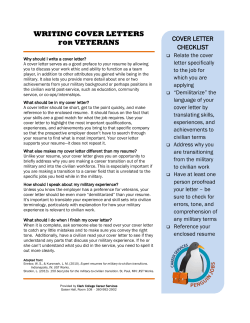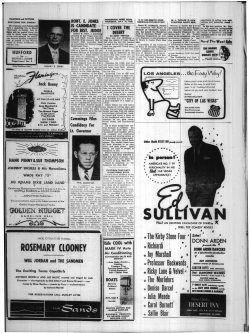
Ocean Steve Clark Whale Rider Waves of Warning
Ocean m a g a z i n e JAN / FEB 2005 Steve Clark 12 Whale Rider 16 Waves of Warning 22 cover FACE TO FACE BY ROBERT WALD T ~ STEVE CLARK HE EARLY MORNING RAIN HAD rinsed the streets of Encinitas clean of carbon dust left behind from another summer of gridlock traffic. From up on surfboard hill, the clearing wind that followed the rain made it possible to view the entire length of Catalina Island, from Avalon to the West End, one hundred miles away. Some enchanted day! It was upon this epic Sunday clear that production from within the patchwork quilt building on the hill had ceased for the Sabbath . . . all but for the beautiful sound of a slide guitar drifting out from beyond a dusty shaping room door. Inside was Steve Clark, mildmannered, soft-spoken owner of Clark Custom Surfboards. Clark was strumming a slack-key tune in the Hawaiian spirit of Ry Cooder. “This is my ‘Rattletail’ model,” Clark says gesturing toward a freshly shaped surfboard laying on the rack. “Listen to it rattle!” It does indeed rattle for entombed within the hollow tail block is the rattler of a rattlesnake . . . modern innovations of surfboard design continue to unfold. Artist, musician, surfer, surfboard designer and shaper, Clark, 55, walks, talks, sleeps and eats surfing, music and art. Born son of a husband and wife attending UCLA in 1949, Clark’s family migrated to Encinitas in 1953. His father, an avid body surfer and paddleboarder who had grown up on the beaches of Redondo, Hermosa and Manhattan, brought his passion for ocean sports to Moonlight Beach. 12 THE OCEAN MAGAZINE • JANUARY / FEBRUARY 2005 story CLARK AT HIS SHOP IN ENCINITAS “When I was real little I used to ride on my dad’s shoulders when he bodysurfed at Moonlight,” Clark said. “We were Moonlight regulars and we knew all the lifeguards. Fred Ashley, LJ Richards, Rusty Miller and Scotty McClaren to name a few. “I first started surfing in 1959 when I was 10 years old at Moonlight. Our neighbor’s daughter bought a surfboard and didn’t like it. I wanted to learn to surf so I bought it from her for $14. I got a ding in the tail and as I began fixing it I peeled up the glass and discovered a Hobie Surfboard sticker under the layers. I couldn’t believe I had been riding a Hobie for a year and half without knowing it was a Hobie! That was a big deal for me. “I’ve had other balsa surfboards. One that I bought from Dale B. Woodward, renowned boat and surfboard builder here in Cardiff. It had a sticker on it that read ‘Bamboo Reef’ written in bamboo letters. Really cool lookin’. I’ve always thought I should resurrect that label.” In ‘65 Clark became a member of Swami’s Surfing Association. The club, established in 1963 was originally named Swami’s Surfing Society. John Price of Surfboards Hawaii, Al Merrick of Channel Island Surfboards, Don Hansen of Hansen Surfboards and little 13 year old Diana Brummett were among charter members of note. At 14 years old Clark was living the ultimate young surfer’s dream. He surfed Swamis everyday and was surrounded by a plethora of talented surfboard manufacturers, all within walking distance of his home. Clark would soon become interested in learning the craft of surfboard production himself. “I was in 10th grade at San Dieguito High when I was hanging around Surfboards Hawaii shop on Highway 101 in Leucadia. Dick Brewer and John Price was there at that time. The boards were shaped, glassed and shipped from this location. Somehow Brewer left and Price took over the label. “They started small and expanded to another building that had two shaping rooms and a shipping department. I got a job packing boards for shipping. This was about the time I became interested in shaping my own surfboards. “Dick Brewer at that time never let anyone watch him shape boards. It was off limits. So I drilled a little CLARK AND GRANDSON LEVI NORTH SHORE, OAHU 2004 ALL PHOTOGRAPHS COURTESTY STEVE CLARK peep hole in the drywall on the other side of his shaping room and I was watching him shape for a good couple of weeks. “So one day me and my buddy Steve Zelinka got out of school to go to work packing surfboards. We heard Brewer in his shaping room getting ready to work so I said to Zelinka ‘He’s in there! Let’s go look!’ “I peeked through the peep hole and said ‘I don’t see him, he’s not in there! Where is he?!’ Then all of a sudden WHAM!, I got a handful of foam dust through the peep hole right into my eye! “Brewer yelled at us and said ‘Close that hole! Don’t ever look at me while I’m working!’ He didn’t get too mad but we got the message!” According to Clark, as Surfboards Hawaii grew they moved their factory to the corner of Highway 101 and D Street next door to the La Paloma Theater. It was formerly occupied by Bank of America. “Price used the bank vault as the sanding room,” Clark said. “Eddie Wright, who later formed Sunset Surfboards was their main shaper at the time. This was ‘65 or ‘66. I learned to gloss from Gary Brummett. After that it gets kind of fuzzy. At some point I got into trouble for playing a joke on the secretary. The whole thing backfired. I was sent packing.” Dejectedly, Clark walked down the street to Hansen’s Surfboards and got a job glossing that very same day. It was during this time working for various manufacturers that Clark cut his teeth on surfboard production. He shaped his first surfboard in 1964 when he was in the ninth grade. YOUNG 1966 STEVE CLARK TRIMS IT ON OUT PHOTO: In 1970 Clark married Melissa, his wife of 34 years. Melissa is an RN at Scripps Encinitas and was voted nurse of the year 2002. “Shortly after my marriage to Melissa I got drafted into the armed forces. This was during the Viet Nam war. I really didn’t want to go shoot anybody so I hid out in Mexico for awhile. When I came back I had another induction notice waiting for me. I tore that up and threw it away and went up to Oregon to attend Southern Oregon College. “The draft board finally caught up with me about a year and a half later with another induction notice and I got sent to Portland for my physical. I was standing in a room with about 200 other guys when an officer comes in and asks if there were any conscientious objectors in the group. I was the only one that raised my hand. They gave me another stack of papers to fill out and I was sent back down to San Diego for a hearing. It was just before I was to attend the hearing that the war had ended.” With the spectre of going to war no longer pestering Clark he resumed what he loved doing best: surfing, creating art and playing music. SHIRLEY BERNARD In the mix of married life Clark finished college, travelled extensively in Mexico, began his own surfboard production company and continued to surf. “I had many memorable days surfing in the ‘70’s in California. Before the invention of tri-fins there didn’t seem to be that many people out surfing. Swami’s, Trestles, La Jolla, all over. The surf was excellent! At the same time I travelled a lot. Driving to Baja and mainland Mexico. Puerto Escondido.” It was during this time that Clark formed a rock ‘n roll band and began touring Mexico. “I had this Volkswagon mini-bus,” Clark said. “We put all the guitars and amps and drums inside and strapped our surfboards on top. We then drove down mainland Mexico to Topolobampo and took the ferry over to La Paz.” A voyage that turned to a thriller at sea. “The ocean was heavy,” Clark remembers, “and the ferry was getting slammed broadside by 20 foot waves. I thought for sure we were going to capsize. We were sitting in the second story of the ferry and the waves were hitting the windows! My heart nearly leapt to my throat when I saw the cap- tain of the ferry wearing a life vest, swim fins and snorkel!” Upon arriving safely in La Paz Clark went to retrieve his bus. He soon discovered that a truck loaded with live chickens had broken free of its restraining chains below deck during the storm. When they opened the gates of the ferry to let the cars out it blew Clark’s mind. “A flood of feathers and clucking chickens were drifting and flying everywhere!” Mucho pollo! Dusting the foul off and bidding the captain of the ferry bye-bye, Clark and his bandmates disembarked, continuing their trek to Cabo San Lucas, surfing and playing gigs at the night clubs downtown. “It was an incredible time,” Clark recalls. “We surfed in the sun and rocked under the moon and stars!” The charm of warm phosphorescent water, good natured locals, excellent waves and smiling huachinangos captured Clark’s heart. But after 4 months in Mexico obligations stateside brought the wandering minstrel home. “In ‘74 I went to work glossing for Alan Weiss at Koast Surfboards.” Clark said. “John Kies, now of Encinitas Surfboards was his head shaper at the time. I picked up a lot of shaping techniques from John. Kies is a really good shaper. Bill Shrosbree and Mike Slingerland were shaping there too.” The year 1975 yielded Clark and his wife Melissa a beautiful daughter, Oceanna. In 2004 Oceanna would give birth to their first grandson, Levi. Levi’s dad, Chris Gage, is an avid surfer and San Diego City firefighter. ‘BLACK CORAL DIAMOND EYED OCTOPUS’ MEXI-PEP BLACK CORAL, CONCH SHELL, DIAMONDS AND GOLD SCULPTURE BY STEVE CLARK THE OCEAN MAGAZINE • JANUARY / FEBRUARY 2005 13 STEVE CLARK TAKES A COLD D Having taken his first step into the world of shaping surfboards, Clark began purchasing the tools necessary to do the job. He bought his first planer in ‘75 from Steve Moret for $100. “I glossed for Koast Surfboards then went over to Clinton Surfboards. This was about the time Nectar Surfboards started. I started shaping Nectar kneeboards for Gary McNabb.” Reflecting on the direction of surfing during the ‘70’s, Clark recalls that “Nobody rode longboards then. Everyone was riding short pintails. Speed was the thing. Get in the tube and do speed turns. I remember a lot of good days surfing in the 70’s.” Honing his skills as a shaper Clark initiated his first surfboard company, International Brotherhood of Surfing or IBS. “Everyone thought IBS stood for exactly that! I bull****. You know the rest. The IBS name was short lived. Then I renamed my business Clark Custom Surfboards. The emblem was a little diamond with plain letters. Real simple. Clear boards. Nothing fancy. “The first five years, from ‘75 to ‘80 I made my boards entirely myself. Shaped, glassed, sanded, glossed and sold. I had a house in Del Mar back then. 5 acres surrounded by nothing. Then I moved back to Encinitas and had a shaping room built on the side. “I shaped the boards at home then delivered them down to Channin Precision Fiberglass to be glassed. STEVE CLARK’S BAJA SURF SQUAD GARTH MURPHY, MIKE DOYLE & JEFF KING “Channin Precision Fiberglass is one of the best surfboard glassing facilities in the world. The technology combined with craftsmanship. Randy Wong, their manager is a vital part of Channin’s operation. He keeps the quality at the highest level. I feel Channin Precision Fiberglass is overlooked by a lot of the surf world. They probably just don’t understand. “I see a lot of kids treat their surfboards like garbage. They should put them in board bags and keep them out of the sun when they aren’t using them. Treat your surfboard like a guitar. With care.” “I’m always going to garage sales looking for a good old surfboard” says Steve Clark, an avid surfboard collector shown here in his archival vault. 14 THE OCEAN MAGAZINE • JANUARY / FEBRUARY 2005 As Clark built his reputation for producing quality surfboards, his list of clients began to grow. Mike Doyle, Jeff King, Garth Murphy, Mark Brolaski, Jeff Mahoney and Pat Curren are among famous surfers who have placed orders with Clark. Since 1991 Clark has been shaping exclusively at the Channin facility and it’s not uncommon for him to produce four to five hundred boards a year. Over his career Clark has shaped surfboards for over twenty-plus different labels. Clark sums up his bread and butter by saying “I just go with the flow. Everything is constantly changing in this business. Sometimes all I shape are longboards then all of a sudden I’m doing guns. Five-sixes to eighteen footers. I shape them all.” In addition to his full time job shaping, Steve Clark is an avid surfboard collector, fine artist and as mentioned earlier in this article, a fine guitar player. In his shaping room along with his tools, shaped boards and blanks are stringed instruments that inspire him. “I like to always have an instrument around to strum, even in the midst of shaping many surfboards. I love playing music. There is definitely magic to it. I still love to jam twice a week with my friends at the ranch.” Clark is also an accomplished sculptor and jeweler, designing and creating works of black coral from the sea canyons of Hawai’i and gold VE CLARK TAKES A COLD DROP CLARK HOLDS HIS OLD VELZY and diamonds from the deep mines of Africa. A consummate artist, surfer, musician, family man and good fella, Steve Clark is definitely one person worth calling on. I’m certainly glad I did. * * * Steve Clark jams on Fender Stratocaster “Relic” with Bob Dylan standing in on bass. THE OCEAN MAGAZINE • JANUARY / FEBRUARY 2005 15
© Copyright 2025













